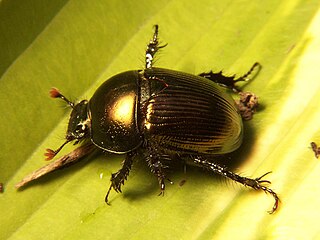
Bolboceratinae is a subfamily of earth-boring scarab beetles in the family Geotrupidae. There are about 8 genera and at least 40 described species in Bolboceratinae.
Odonteus darlingtoni is a species of earth-boring scarab beetle in the family Geotrupidae. It is found in North America.
Nicagus occultus is a species of stag beetle in the family Lucanidae. It is found in North America.
Odonteus floridensis is a species of earth-boring scarab beetle in the family Geotrupidae. It is found in North America.
Hyperaspis paludicola, the swamp lady beetle, is a species of lady beetle in the family Coccinellidae. It is found in North America.

Chrysobothris shawnee is a species of metallic wood-boring beetle in the family Buprestidae. It is found in North America.
Chrysobothris adelpha is a species of metallic wood-boring beetle in the family Buprestidae. It is found in North America.
Mulsantina hudsonica, the hudsonian lady beetle, is a species of lady beetle in the family Coccinellidae. It is found in North America.
Agrilus muticus is a species of metallic wood-boring beetle in the family Buprestidae. It is found in North America.
Acmaeoderoides ferruginis is a species of metallic wood-boring beetle in the family Buprestidae. It is found in North America.
Epilachna tredecimnotata, the southern squash lady beetle, is a species of plant-eating lady beetle in the family Coccinellidae. It is found in the Caribbean, Central America, North America, and South America.
Dichelonyx elongatula is a species of scarab beetle in the family Scarabaeidae. It is found in North America.
Platyceroides laticollis is a species of stag beetle in the family Lucanidae. It is found in North America.
Eurypogon californicus is a species of soft-bodied plant beetle in the family Artematopodidae. It is found in North America.
Hyperaspis bolteri is a species of lady beetle in the family Coccinellidae. It is found in North America.
Brachiacantha tau, the t-marked lady beetle, is a species of lady beetle in the family Coccinellidae. It is found in North America.
Odonteus alabamensis is a species of earth-boring scarab beetle in the family Geotrupidae. It is found in North America.
Odonteus liebecki is a species of earth-boring scarab beetle in the family Geotrupidae. It is found in North America.
Odonteus thoracicornis is a species of earth-boring scarab beetle in the family Geotrupidae. It is found in North America.
Odonteus falli is a species of earth-boring scarab beetle in the family Geotrupidae. It is found in North America.




